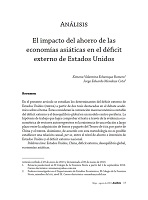El impacto del ahorro de las economías asiáticas en el déficit externo de Estados Unidos
DOI:
https://doi.org/10.32870/mycp.v2i4.402Keywords:
Estados Unidos, China, déficit externo, desequilibrio global, economías asiáticas.Abstract
En el presente artículo se estudian los determinantes del déficit externo de Estados Unidos (deeua) a partir de dos tesis destacadas en el debate acadé- mico sobre el tema. Éstas consideran la convención macroeconómica contable del déficit externo y el desequilibrio global en un modelo centro-periferia. La hipótesis de trabajo que logra comprobar el texto a través de la evidencia econométrica de vectores autorregresivos es la existencia de una relación a largo plazo entre la adquisición de bonos y pagarés del Tesoro de eua por parte de China y el deeua. Asimismo, de acuerdo con esta metodología no es posible establecer una relación causal, per se, entre el nivel de ahorro e inversión de Estados Unidos y el déficit externo nacional. Abstract:This paper examines the determinants of U. S. external deficit (used) focusing on two outstanding thesis in the academic debate. They consider the macroeconomic accounting convention and the global imbalances in a center-periphery model. Also, the Bernanke’s thesis is analyzed, particularly the direct relationship between investments in U. S. capital account, saving peripheral and used. Finally, a time series econometric model is provided that relates the external deficit of the usa to the domestic savings and investment of that country and to the Chinese economy’s acquisition of U. S. Treasury Bonds. The outcomes showed a long run positive correlation between the U. S. external deficit growth and the acquisition of U. S. Treasury Bonds by the Chinese economyDownloads
References
Barattieri, Alessandro (2011), “Comparative Advantage, Service Trade, and Global Imbalances”, Journees Cirpée, Cahier de recherché/Working Paper, núm. 11-34, octubre.
Bernanke, Ben S. (2005), “The Global Saving Glut and the U. S. Current Account Deficit”, Sandridge Lecture, Virginia Association of Economists, 10 de marzo, Nueva York: Federal Reserve Bank of New York.
—— (2009), “Financial Reforms to Address Systemic Risk”, Speech at the Council of Foreign Relation, 10 de marzo, Washington, dc.
Blanchard, Olivier, y Giann Maria Milesi-Ferretti (2009), “Global Imbalances: In Midstream”, imf Staff Position Note spn/09/29, Washington, dc: International Monetary Fund.
Cheung, Yin-Wong, Menzie D. Chinn, y Eiji Fujii (2007), “The Overvaluation of Renminbi Undervaluation”, Journal of International Money and Finance, 26(5), Elsevier, pp. 762-785.
Chinn, Menzie D., y Hiro Ito (2008), “Global Current Account Imbalances. American Fiscal Policy versus East Asian Savings”, Review of International Economics, 16(3), pp. 479-498.
Clarida, R. (2005), “Japan, China, and the U. S. Current account deficit”, cato Journal, 25(1), invierno. Congress of the United States Congressional
Budget Office (2010), Fannie Mac, Freddie Mac, and the Federal Role in the Secondary Mortgage Market, Washington, dc, pp. 1-14.
Dooley, Michael, David Folkerts-Landav, y Peter M. Garber (2004), “The us Current Account Deficit and Economic Development: Collateral for a Total Return Swap”, nber Working Paper, núm. W10727, National Bureau of Economic Research.

Downloads
Published
How to Cite
Issue
Section
License
Open Access Policy
This journal provides open access to all its contents, in adherence to the principle that making research freely available supports a greater global exchange of knowledge.
MyCP is licensed under a Creative Commons Attribution-NonCommercial license, also known as CC BY-NC.
Contents are published in both PDF and XML formats.
Authors who publish in México y la Cuenca del Pacífico must accept the following conditions:
Pursuant to Mexican copyright laws, México y la Cuenca del Pacífico acknowledges and respects the authors’ moral right and ownership of property rights, which will be assigned to the University of Guadalajara to publish the articles in an open-access mode.
México y la Cuenca del Pacífico does not charge the authors any fees for receiving and processing their articles.
Authors are permitted to enter into other independent and additional contractual agreements for the non-exclusive distribution of the article version published in México y la Cuenca del Pacífico (for example, publishing it in an institutional repository or in other printed or electronic media) as long as they clearly state that the piece was originally published in México y la Cuenca del Pacífico.
Pursuant to the above, once the article is approved for publication, authors must send the Assignment of Rights Agreement form duly filled and signed. This form must be sent to mexicoylacuenca@gmail.com as a PDF file.
Readers/users of México y la Cuenca del Pacífico can freely access the journal new issues as soon as they are uploaded. Readers/users are allowed to cite, share (both electronically and physically), print and distribute the material, provided they expressly state that the work was originally published in México y la Cuenca del Pacífico. Contents are to be properly cited and never for commercial purposes.




